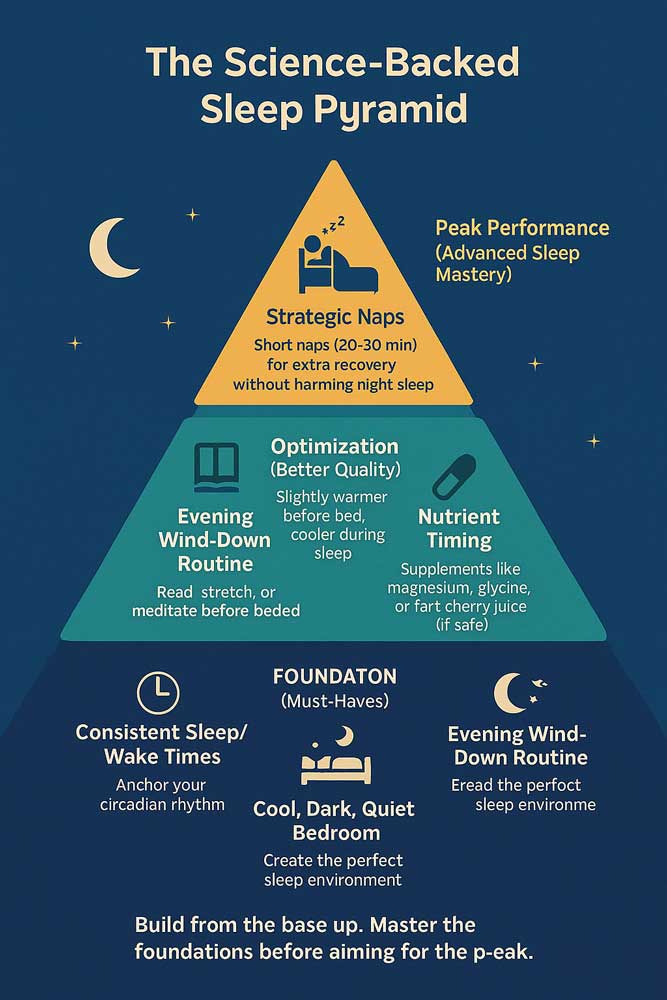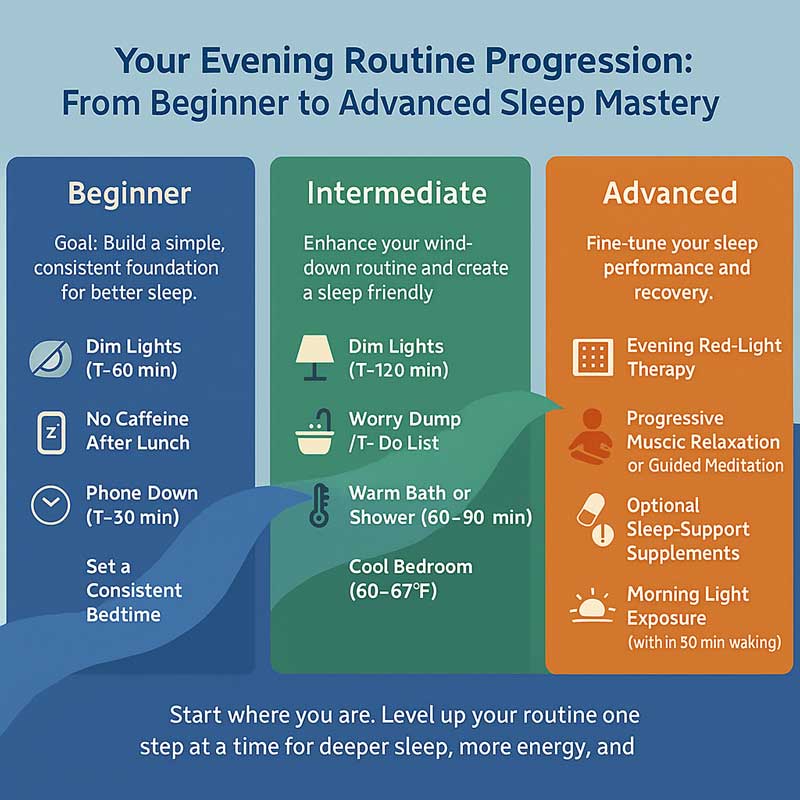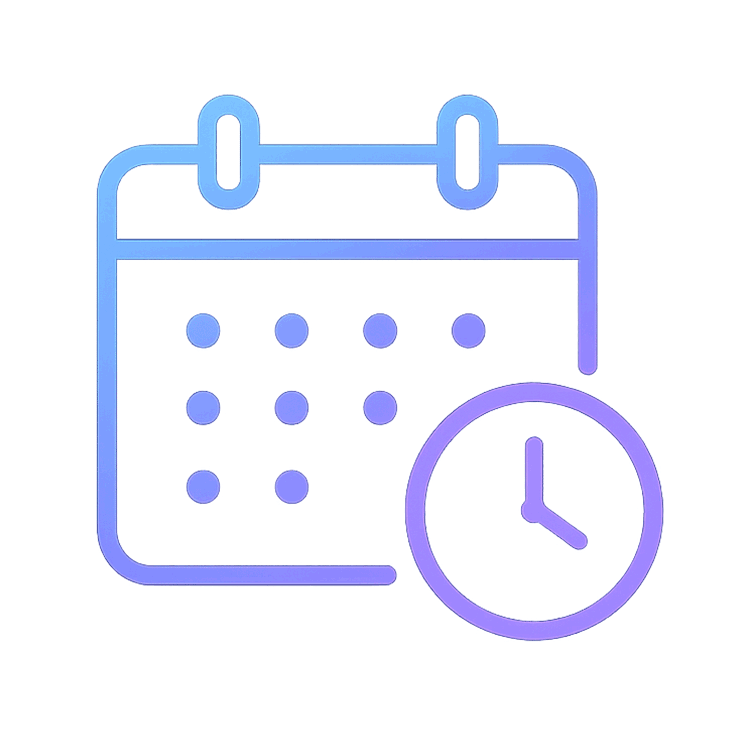Most people underestimate how much their evening habits influence their mornings. The final two hours before bed can determine:
- How quickly you fall asleep
- How deeply you rest
- How refreshed you feel when you wake
While much online advice focuses on avoiding screens or sipping chamomile tea, there’s far more you can do — and science backs it up. This guide combines research-based sleep strategies with practical, actionable steps to help you enjoy deeper, more restorative sleep starting tonight.
Why Your Evening Routine Matters More Than You Think
The Science of Sleep Cycles
Your body runs on a natural 24-hour clock called the circadian rhythm — mainly controlled by light exposure. In the evening, exposure to bright, cool-toned (blue) light suppresses melatonin, your primary sleep hormone, and can delay your body clock, making it harder to fall asleep and wake refreshed. Even typical indoor lighting can have this effect if it’s bright and cool. (https://www.sleepfoundation.org/circadian-rhythm).
Alongside your circadian rhythm is sleep pressure, the buildup of your brain’s need for rest. This pressure increases throughout the day due to a compound called adenosine. Caffeine blocks adenosine, which is why drinking coffee or tea too late can keep you wired even if you feel “tired.” Research shows that caffeine consumed six hours before bedtime can reduce total sleep time by over an hour (https://pubmed.ncbi.nlm.nih.gov/24235903/).
Evening Choices That Sabotage Your Morning

Small, seemingly harmless habits in the evening can have a big impact on how you feel the next day:
- Late-night screen use — Blue light from devices reduces melatonin production, delaying sleep onset.
- Caffeine after midday — Even if you manage to fall asleep, your deep sleep quality may suffer.
- Overheating — A too-warm bedroom can prevent the natural drop in core temperature needed for deep sleep. Optimal range: 60–67°F (15–19°C).
The good news? With small, intentional changes, you can train your body to expect sleep at the right time, making it easier to fall asleep quickly and wake up feeling truly recharged.
Your 6–Step Science-Backed Evening Routine Timeline

The key to better sleep isn’t just what you do before bed, but when you do it.
Here’s a countdown routine starting two hours before bedtime to prepare your body and mind for deep, restorative sleep.
Step 1: T-120 Minutes — Light, Food, and Movement Adjustments
- Dim the lights and switch to warm lighting. Exposure to dim, warm-toned light supports melatonin production, while bright, blue-toned light delays it.
- Avoid heavy or spicy meals from this point on. These can raise your core temperature and cause indigestion, which disrupts sleep. If you’re hungry later, choose calming snacks such as yogurt, kiwi, tart cherry, or almonds (https://pubmed.ncbi.nlm.nih.gov/21118046/).
- Opt for gentle movement like stretching, light yoga, or a short walk. Avoid intense workouts in the last two hours before bed, as they can raise adrenaline and body temperature.
- Cut off caffeine at least six hours before bedtime. Even moderate caffeine intake in the afternoon can reduce deep sleep and total sleep time.
Step 2: T-90 Minutes — Digital Detox & Mental Offloading
- Power down screens or activate the warmest night mode possible. Blue light from devices delays melatonin and shifts your circadian rhythm later.
- Do a “worry dump” or to-do list in a notebook. Research shows that writing down tomorrow’s tasks before bed can help you fall asleep faster by reducing cognitive load.
Step 3: T-60 Minutes — Thermal & Sensory Wind-Down
- Take a warm bath or shower about 60–90 minutes before bed. As your body cools afterward, your core temperature drops, triggering sleepiness.
- Optional aromatherapy: Scents like lavender or chamomile may help reduce pre-sleep anxiety and promote relaxation.
Step 4: T-30 Minutes — Mind & Breath Reset
- Practice progressive muscle relaxation (PMR): Tense and release muscle groups from head to toe to release built-up tension. PMR has been shown to improve sleep quality in multiple studies.
- Try slow breathing techniques such as the 4-7-8 method or alternate nostril breathing. Slow breathing (4–6 breaths per minute) can activate your parasympathetic nervous system, lowering heart rate and calming the mind.
Step 5: T-0 Minutes — Sleep Sanctuary Setup
- Cool, dark, quiet: Set your bedroom temperature to 60–67°F (15–19°C), use blackout curtains, and consider white or pink noise if you live in a noisy area (https://www.sleepfoundation.org/bedroom-environment/best-temperature-for-sleep).
- Bed = sleep only: If you can’t sleep after ~20 minutes, get out of bed and do a quiet, low-light activity until you feel drowsy. This “stimulus control” technique is a core part of Cognitive Behavioral Therapy for Insomnia.
Step 6: The Morning-After Reset
- Get bright light exposure within 30 minutes of waking, ideally outdoors. Morning light helps stop melatonin production, reinforces your circadian rhythm, and makes it easier to fall asleep at night.
- Hydrate and stretch: A glass of water plus 2–5 minutes of gentle movement helps signal to your body that the day has begun.
Advanced Evening Routine Hacks

Once you’ve mastered the basics, you can layer in these science-backed upgrades to deepen sleep quality, reduce nighttime wake-ups, and improve your morning energy.
-
Biohacking Your Sleep Environment
- Wearable sleep trackers like Oura Ring or Whoop can help you monitor trends in sleep duration, stages, and recovery. While they’re not perfect, they can reveal patterns that help you fine-tune your routine.
- Red-light therapy in the evening may help maintain melatonin levels by avoiding blue-light suppression while still providing enough light to move around safely.
- Temperature-regulating bedding (cooling mattresses, weighted blankets) can help if you struggle with overheating or restlessness.
-
Evidence-Based Supplementation
Supplements aren’t magic bullets — but some can offer small, measurable benefits when used correctly:
- Glycine (3 g, 30–60 min before bed): May reduce sleep onset time and improve next-day alertness, especially after short sleep.
- Tart cherry juice: Contains melatonin and anti-inflammatory compounds that can modestly improve sleep duration and efficiency (https://pubmed.ncbi.nlm.nih.gov/22038497/).
- Magnesium (e.g., glycinate or citrate): May improve sleep quality, particularly in people with low magnesium levels; effects are mild but well-tolerated.
- Valerian root: Evidence is mixed, and effects tend to be mild; may be worth trying if you prefer herbal approaches.
Note: Always check for interactions with medications and consult a healthcare professional before starting new supplements.
-
Circadian Anchors for Travel & Shift Work
If your schedule is irregular, you can still train your body to adapt faster:
- Morning light at your target wake time — even if you’re traveling — helps your circadian clock shift to the new schedule (https://www.sleepfoundation.org/circadian-rhythm/shift-work-disorder).
- Meal timing: Align your eating schedule with your intended sleep-wake cycle; this can help reinforce circadian cues.
- Night-shift adaptation: Use bright light during your work hours and blackout curtains afterward to help your body recognize “night” and “day” on your shifted schedule.
How to Personalize Your Night Routine
No two lives are the same — and your sleep routine shouldn’t be either. The following tailored blueprints help you adapt the science-backed evening framework to your specific lifestyle, so you can still reap the benefits even when time or circumstances are limited.
For Parents with Limited Evening Time
If you’re juggling childcare and household tasks, you may not have a full two hours for wind-down. In that case:
- Micro-routine (20–30 minutes):
- Dim the lights as soon as possible.
- 3-minute to-do list for tomorrow to reduce mental load.
- 5–10 minutes of gentle stretching or yoga with your children if possible.
- Bedtime story or quiet music shared with kids as part of their wind-down.
- 2 minutes of slow breathing in bed before sleep.
Consistency matters more than length — even short routines can train your body for rest if done nightly.
For High-Stress Professionals
If your mind races at night due to work demands, you need stronger cognitive “off-switches”:
- 90-minute cutoff for work & emails — Set a phone alarm as a reminder.
- 5-minute “brain dump” of tasks and worries to avoid ruminating in bed.
- 10–15 minutes of progressive muscle relaxation (PMR) or a guided body scan to lower stress hormone levels.
- Keep your bedroom cool and free from work-related items to reinforce separation between work and rest.
For Shift Workers
Your biggest challenge is aligning your body clock with irregular hours. You’ll need stronger circadian cues:
- Bright light therapy during your working “day” to suppress melatonin and keep you alert.
- Blackout curtains and sleep masks during your “night” to block sunlight and support melatonin production.
- Consistent pre-sleep ritual even if it’s daytime: light stretching, warm shower, blackout environment, and white noise to mask daytime disturbances.
- Meal timing: Eat your largest meal during your active period, not before sleep, to avoid digestive disruption.
Troubleshooting Your Sleep Routine
Even with the best intentions, there will be nights when sleep doesn’t come easily. The key is knowing how to respond without making things worse. Here’s how to fix the most common problems.
If You Can’t Fall Asleep
- Follow the 20-minute rule: If you’re not asleep after ~20 minutes, get out of bed and do a quiet, low-light activity like reading a paperback or listening to calm audio. This prevents your brain from associating the bed with wakefulness.
- Avoid screens — even dimmed ones — since blue light can delay melatonin.
- Use a calming technique: Try progressive muscle relaxation or slow breathing (4–6 breaths per minute) to activate your parasympathetic nervous system.
If You Wake Up During the Night
- Keep lights low if you need to get up — bright light can reset your circadian rhythm and make it harder to return to sleep.
- Try a “body scan” meditation to quiet a racing mind and relax tense muscles.
- Avoid checking the clock, which can increase stress and further delay sleep.
If You Wake Up Tired
- Audit the big four:
- Evening light exposure (too bright or too much screen time?)
- Caffeine timing (anything after midday?)
- Bedroom temperature (too warm for optimal sleep?)
- Morning light exposure (getting enough to anchor your circadian rhythm?)
- Short early-afternoon nap: 10–20 minutes can improve alertness without harming nighttime sleep — but avoid naps late in the day.
- Hydration and movement within the first 30 minutes of waking can help kickstart your body’s alertness cycle.
Your One-Page Evening Routine Checklist

Save or print this quick-reference guide to make your nightly wind-down effortless. Follow it consistently, and your body will begin to anticipate sleep — making it easier to fall asleep and wake up refreshed.
T-120 Minutes (2 Hours Before Bed)
- Dim household lights; switch to warm bulbs.
- Finish any heavy or spicy meals; avoid alcohol and caffeine.
- Do gentle movement — light yoga, stretching, or walking.
T-90 Minutes
- Turn off or dim all screens; enable night mode if still in use.
- Write tomorrow’s to-do list or “worry dump” to clear your mind.
T-60 Minutes
- Take a warm bath or shower to trigger a natural body temperature drop.
- Optional: Use calming scents like lavender or chamomile.
T-30 Minutes
- Practice progressive muscle relaxation.
- Try slow breathing (4–6 breaths/minute) to relax.
T-0 Minutes (Lights Out)
- Keep bedroom cool (60–67°F / 15–19°C) and dark.
- If not asleep after 20 minutes, get up and do a calm, non-screen activity.
Morning Reset
- Get bright outdoor light within 30 minutes of waking.
- Hydrate and do gentle stretches to signal your body to start the day
Conclusion: Small Changes, Big Sleep Gains
A great night’s sleep isn’t just about the hours you spend in bed — it’s about how you prepare for it.
By following a consistent, science-backed evening routine, you can:
- Fall asleep faster
- Stay asleep longer
- Wake up more energized and focused
Whether you start with dimming the lights earlier, swapping your phone for a notebook, or adding a warm shower before bed, each habit is a signal to your body: it’s time to rest. Over time, these signals become automatic, making quality sleep your default state.
Remember — your evening routine isn’t just about better nights, it’s about better mornings, sharper thinking, and improved mood.
Your next step:
Start tonight with just one or two changes from the checklist above. Track your sleep quality for a week, then add more habits gradually. Small, consistent changes will have the biggest impact.








